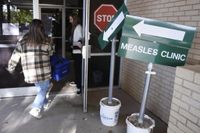The U.S. measles outbreak has surged to 800 confirmed cases across 24 states, according to the Centers for Disease Control and Prevention (CDC) on Friday, April 18, 2025. The latest report indicates a concerning trend, with 88 new cases reported in just the previous week. This outbreak, which has already claimed two lives, with a third death under investigation, marks a significant increase compared to the 285 cases recorded in all of 2024.
If the current growth rate continues, the U.S. could surpass the total number of cases seen in 2019, which was 1,274, potentially reaching the highest levels since 1992. Six states are currently experiencing significant outbreaks, defined as three or more related cases: Texas, New Mexico, Ohio, Kansas, Indiana, and Michigan. The virus has been detected in 24 states overall, including Alaska, Arkansas, California, Colorado, Florida, Georgia, Hawaii, Kentucky, Maryland, Minnesota, New Jersey, New York, Oklahoma, Pennsylvania, Rhode Island, Tennessee, Vermont, and Washington.
Health officials have noted that a staggering 96% of this year’s cases have occurred in unvaccinated individuals or those with unknown vaccination status. This alarming trend threatens the nation’s measles elimination status, which was achieved in 2000 when the U.S. recorded no continuous spread of the disease for 12 months. The current outbreak, which began in Texas in January, could jeopardize this status if it persists for more than a year.
Measles is a highly contagious viral infection that spreads through coughing and sneezing. According to the CDC, the virus can survive in the air for up to two hours after an infected person leaves a room. Early symptoms typically include high fever, cough, runny nose, and watery eyes, with the characteristic rash appearing three to five days after the initial symptoms. A person can spread the virus four days before and four days after the rash appears.
The CDC emphasizes that the measles, mumps, rubella (MMR) vaccine is highly effective, with two doses providing 97% protection against the virus. Children are advised to receive their first dose between 12 to 15 months of age and a second dose between 4 to 6 years old. International travel by unvaccinated individuals has historically been a significant factor in bringing measles into the United States. The CDC recommends that all international travelers be fully vaccinated against measles before departure, regardless of their destination.
As of the latest reports, Texas is the epicenter of the outbreak, with 597 cases concentrated primarily in West Texas. The outbreak has resulted in the tragic deaths of two unvaccinated elementary school-aged children due to measles-related illnesses. Additionally, an adult in New Mexico who was not vaccinated has also died from a measles-related illness. In Texas alone, health officials reported 36 new cases since Tuesday, April 15, 2025, bringing the total to 597 across 25 counties.
Among the Texas cases, 62% are located in Gaines County, a close-knit, undervaccinated Mennonite community where the virus began spreading. The county has logged 371 cases since late January, which represents just over 1% of the county’s population of 22,892. The death of an 8-year-old child from measles pulmonary failure was reported on April 3, 2025, while another unvaccinated child without underlying health conditions died in late February.
New Mexico has also seen a rise in cases, with five new infections reported this week, bringing the state total to 63. Six individuals have been hospitalized since the outbreak began, and three new hospitalizations were reported this week. Most cases in New Mexico are linked to the outbreak in Texas based on genetic testing.
Kansas has reported 37 cases across eight counties in the southwestern part of the state, with the first reported case linked to the Texas and New Mexico outbreaks. Meanwhile, Oklahoma has maintained a steady count of 12 total cases, including nine confirmed and three probable, with exposures confirmed in various counties.
Ohio has confirmed 30 measles cases as of April 17, 2025, with outbreaks in Ashtabula County and Knox County. Indiana has reported six connected cases in Allen County, while Pennsylvania declared an outbreak in Erie County after confirming two new cases. Michigan, with three linked cases in Montcalm County, also reported seven confirmed cases overall.
In addition to the U.S. outbreak, a significant outbreak in Ontario, Canada, has sickened 925 individuals since mid-October 2024, and a large outbreak in Chihuahua state, Mexico, has reported 433 cases as of April 18, 2025. This situation underscores the interconnectedness of measles outbreaks across borders, prompting health officials in Canada and Mexico to collaborate with the CDC to monitor cross-border transmission and align public messaging.
Despite the availability of the MMR vaccine, public health officials face challenges in increasing vaccination rates. Misinformation and mistrust, particularly stemming from a now-debunked 1998 study linking the MMR vaccine to autism, have contributed to vaccine skepticism. The COVID-19 pandemic has exacerbated these issues, leading to a decline in childhood vaccination rates nationwide.
Efforts to combat the outbreak include mobile vaccination clinics, school-based immunization drives, and targeted outreach to at-risk populations in Texas and other high-burden areas. The CDC has increased surveillance, expanded testing access, and provided guidance to clinicians on recognizing and reporting measles cases quickly.
As the outbreak continues to unfold, the World Health Organization has expressed concern over the global implications of the resurgence of measles, urging countries to reinforce routine immunization programs. With the current outbreak threatening to escalate, the importance of vaccination as a critical preventive measure cannot be overstated.




